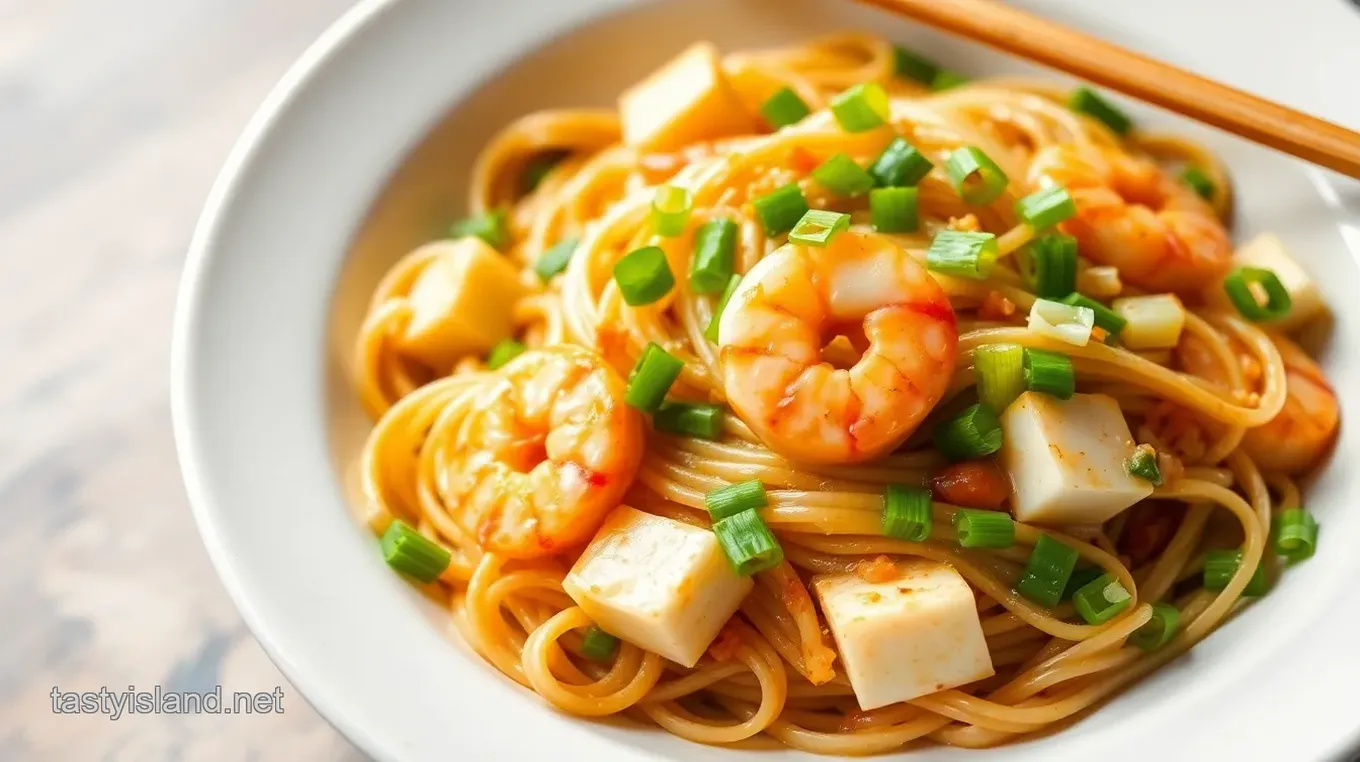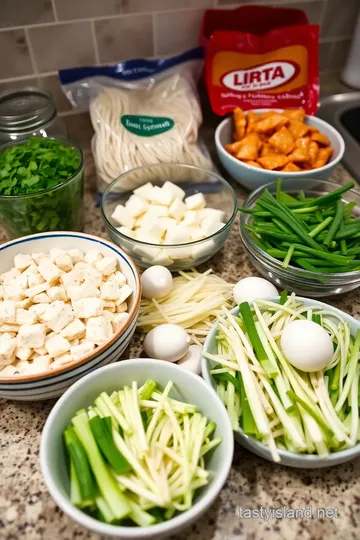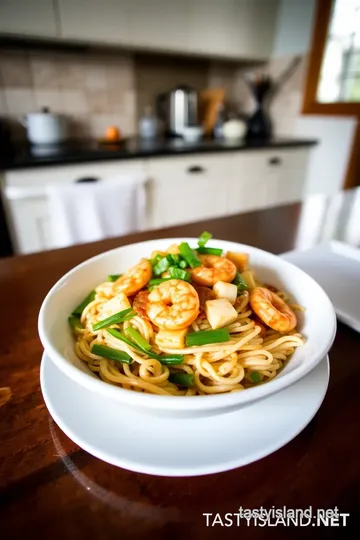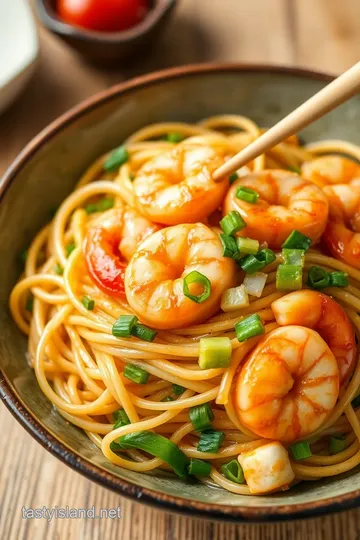Fabulous Stir-Fry Noodles with Tasty Shrimp
Looking for a vibrant meal? Try my Fabulous Stir-Fry Noodles with Tasty Shrimp, bursting with fresh vegetables and savory flavors! It's quick and easy!

Let's look into into Flavor: The Tale of Fabulous Stir-Fry Noodles with Tasty Shrimp
Oh my gosh, have you ever come home after a long day, just wanting something quick, but also tasty? i remember this one time i was foraging through my fridge and found some sad-looking veggies, a bag of rice noodles, and—bam!—a pack of shrimp just waiting to be brought to life.
And you know what i made? fabulous stir-fry noodles with tasty shrimp! seriously, it's like a burst of flavor right in your mouth, and the best part? it’s one of those asian stir-fry recipes that come together quicker than you can whip up a cup of coffee.
The beauty of this dish is in its simplicity. you get to sauté those vibrant veggies and shrimp, toss in some garlic and ginger, and wow—talk about easy homemade stir-fry sauce magic! plus, it totally feels like i'm bringing a piece of a bustling asian street market right to my dinner table.
It’s not just a meal; it’s an experience!
The Birth of Stir-Fry Noodles
Now, let's talk a bit about the history of stir-fry. it all started way back in the han dynasty in china.
Seriously, this dish has roots that stretch back thousands of years! fast forward to today, and this shrimp noodle stir-fry is loved everywhere.
You can find it at fancy restaurants or from your favorite local takeout spot. it’s crazy how something so humble has become so popular.
In terms of time, you’re looking at just about 25 minutes total —15 for prep and 10 for cooking. it’s also a medium-level recipe—not super easy, but not complicated either.
Honestly, if you can chop veggies and follow instructions, you’re golden! and let’s not forget cost—this dish generally takes about $15 for four servings.
So, it’s a win for your wallet too!
Health Benefits Worth This Flavor Bomb
When i think about healthy shrimp recipes , this one jumps right to mind. shrimp is a protein-packed meal , rich in nutrients like omega-3s.
Pair that with a colorful vegetable stir-fry, and you’ve got yourself a healthy feast. this dish is seriously light and fresh—perfect for those busy weeknights when you wanna eat smart but still treat yourself.
What i love about this dish is its versatility. you can easily make it vegan or vegetarian just by swapping the shrimp for some yummy tofu or veggies.
It’s family-friendly and a hit for everyone, from picky eaters to foodies!
Why This Dish is a Must-Try
Why should you make fabulous stir-fry noodles with tasty shrimp tonight? well, for one, it’s super easy to whip up.
You get the satisfaction of cooking a meal that feels fancy but takes less time than ordering takeout. plus, the sticky, savory sauce brings it all together like a warm hug on a plate.
Oh, and let’s be real—how often do you get to enjoy those street food flavors in your own kitchen, right? From the crunch of the veggies to the tenderness of the shrimp, every bite is a flavor explosion!
Ready to get started? Let’s take a look at what you’ll need for this shrimp and vegetable stir-fry . Buckle up, folks; it’s about to become your new go-to dish!

Essential Ingredients Guide
Cooking is like a love letter, and the ingredients are the words you choose. mindfully picking your staples can make or break a dish, especially when you're whipping up something like fabulous stir-fry noodles with tasty shrimp .
So, let’s chat about those essential ingredients that make your meals pop!
Premium Core Components
First things first. measurements matter! whether you’re using us cups or metric grams , get those numbers right! seriously, nothing’s worse than a dish that doesn’t taste as it should.
Here’s a little cheat sheet for you:
- Rice Noodles: 8 ounces (225 grams)
- Shrimp: 1 pound (450 grams)
Now, let’s talk quality indicators . fresh shrimp should smell like the ocean (in a good way, of course) and be slightly firm to the touch.
For veggies, bright colors and a little crispness are the signs you're looking for. nobody wants sad, wilted greens in their shrimp noodle stir-fry , am i right?
Storage is key. keep those veggies in the fridge to stay fresh for longer, and shrimp should be used quick! store your sauce in an airtight container and put it in the fridge—use within a week for maximum flavor.
Signature Seasoning Blend
Now we get to the good stuff! a well-blended, easy homemade stir-fry sauce can really elevate your dish. a mix of soy sauce , oyster sauce , and a splash of sesame oil adds depth.
Pair your spices right. for a kick, add garlic and ginger . and if you’re feeling spicy, don’t shy away from those crushed red pepper flakes.
They’ll turn your dish into a fiery delight!
For those who love to explore, try regional variations. ever tried a thai-style shrimp and vegetable stir-fry ? yum! you can always play with herb selections ; fresh cilantro adds a nice twist—and a bit of fresh zing.
Smart Substitutions
Sometimes you gotta roll with the punches! if you don’t have shrimp handy, don’t sweat it. chicken, tofu, or even sautéed bok choy can step in.
Also, if you’re cooking for someone who’s gluten-free, tamari can be your go-to substitute for soy sauce.
And for those last-minute dinners, having some common alternatives on hand is super handy. No rice noodles? Grab that spaghetti lurking in your pantry. Seriously!
If you’re looking to tweak a recipe for dietary needs, consider seasonal options . Swap out your usual veggies for whatever’s fresh at the market. It keeps things fun and healthy!
Kitchen Equipment Essentials
Alright, let’s get down to business! you don't need a ton of fancy gadgets to make a meal. just grab your trusty wok or a large skillet, some measuring cups, and a good knife for prepping.
When you're blossoming into a stir-fry guru, a good spatula can be your best friend. You want to toss those noodles and shrimp around with flair!
Make sure you know how to store your tools too! Keep your knives sharp and your wok clean. A little TLC can keep them working wonders in your kitchen.
Wrapping it Up!
So, there you have it! these tips will set you on the right path to creating quick weeknight meals that wow your family! grab your ingredients, channel your inner chef, and get ready to craft that fabulous stir-fry noodles with tasty shrimp .
Trust me, once you have these essentials down, you’ll be cooking up a storm in no time.
Stay tuned for the next part where I'll walk you through the step-by-step instructions. Because, honestly? It’s easier than you think to create tasty, protein-packed meals your taste buds will thank you for! Let’s get stir-frying!
Master the Art of Professional Cooking
Okay, friends, let’s dive into the world of professional cooking methods ! honestly, whether you’re whipping up some fabulous stir-fry noodles with tasty shrimp or just trying to get dinner on the table; there are some essential steps to keep in mind.
Think of it as a mini cooking class where you're the chef!
Essential Preparation Steps
First things first: mise en place . this fancy term just means “everything in its place.” seriously, before you even turn on that stove, chop your veggies, measure out your sauces, and have everything ready to go.
It saves you from running around looking for that missing bottle of soy sauce when you're in the middle of cooking.
Trust me, i’ve been there, and it ain’t pretty!
Now, let's talk time management . cooking is like a dance, and you've got to know your moves. while your rice noodles boil (about 8 minutes until al dente , just to be precise), you can get your shrimp all prepped.
Keeping an eye on your clock prevents you from overcooking those poor noodles.
Organization is key too. arrange those ingredients like you're setting up a killer charcuterie board. and don’t forget about safety! keep those sharp knives away from tiny fingers and make sure your cooking area is clean.
A clean kitchen is a happy kitchen!
Step-by-Step Process
Time to break it down! Here’s your step-by-step guide to making that shrimp noodle stir-fry like a pro:
-
Boil the noodles : get a pot of water boiling, toss in those 8 ounces of dried rice noodles , and let them work their magic for about 5- 8 minutes .
Keep stirring so they don’t stick!
-
Prepare the Sauce : In a separate bowl, mix together your soy sauce, oyster sauce, and sesame oil. This should only take a minute.
-
Sauté the shrimp : heat your wok to medium-high , add a tablespoon of vegetable oil, and toss in your 1 pound of large shrimp .
Cook for a quick 2- 3 minutes until pink . remove these beauties from the wok.
-
Cook the Veggies : In the same wok, add your hardest veggies first — bell peppers, broccoli, and carrots take about 5 minutes . Keep it colorful for that awesome visual appeal!
-
Combine and Serve : Throw those cooked noodles and shrimp back into the wok. Pour your sauce over everything and toss to combine for about 2 minutes until heated through.
Expert Techniques
Alright, let’s step it up a notch! Think of these expert techniques as little insider secrets that can really elevate your stir-fry game.
- Use high heat for that perfect caramelization . Low and slow is great for stews but not for quick meals like this.
- Pay attention to timing . Overcooked shrimp taste rubbery and sad. You want them just opaque and juicy!
- Always do a quick taste test. A sprinkle more soy here, a dash of seasoning there can make a massive difference.
Don’t forget about your quality checkpoints . If your veggies aren’t bright and crispy, they probably need a bit more time or a higher heat.
Success Strategies
Now, nobody’s perfect, and that's cool! But here are some success strategies to make sure you nail that perfect shrimp and vegetable stir-fry every time.
- Common mistakes : Overcrowding the pan is a biggie. It leads to steaming instead of searing. So, if you've got a lot to cook, do it in batches!
- Quality assurance : Keep an eye on those colors! If your garlic and ginger aren’t fragrant, you're probably cooking them too low.
- Got leftovers? Great! Make-ahead is the name of the game. Pre-cook your protein and store it in the fridge. Just toss it back in the wok when it’s go-time.
Okay, so now that you’re ready to conquer your kitchen with fabulous stir-fry noodles and that irresistible garlic ginger shrimp , let’s keep this momentum going!
Additional Information
For more cooking tips, fun recipes, and things that simplify your weeknight meals, stay tuned. We’re going to delve deeper into simple stir-fry techniques , and trust me, your taste buds will thank you! Time to get cooking, and may your kitchen be filled with great flavors!

Pro Tips & Secrets
Alright, so let’s dive deeper into making those Fabulous Stir-Fry Noodles with Tasty Shrimp shine at your dinner table! Here are some of my personal golden nuggets I learned along the way.
Chef's Personal Insights
First off, don’t rush the process. you wanna get that lovely garlicky aroma without burning your garlic. start by sautéing your ginger and garlic low and slow to release those oils, then bring the heat to cook your shrimp and veggies.
Trust me, it’s a game changer!
Time-Saving Techniques
Want a quicker meal? pre-chop your veggies ahead of time. seriously, do this while you’re binging netflix; it’ll save you so much hassle during the week.
And don’t forget about those shrimps ; you can buy them already peeled and deveined at the store. it’s like a cooking hack that saves time and energy!
Flavor Enhancement Tips
For a flavor kick, add a splash of rice vinegar or a squeeze of lime juice right before serving. this little zinger makes the entire dish pop! and if you’re into spicy, toss in some red pepper flakes for those spicy shrimp noodles vibes.
Presentation Advice
Let’s talk about making your dish visually stunning. layer those colorful ingredients in the bowl. start with the noodles, then pile on the veggie and shrimp mix.
Finish with a sprinkle of sesame seeds and some freshly chopped herbs, like cilantro. it’ll absolutely wow your guests!
Perfect Presentation
Now, onto plating. Presentation can turn a basic stir-fry into something special.
Plating Techniques
Use a large shallow bowl for a beautiful display. Tuck your noodles into the center, arrange your vegetables and shrimp artfully around the edges. It's like food art!
Garnish Ideas
Want to jazz it up? Add fresh cilantro, basil, or even thinly sliced chili on top for that authentic Asian street food flair. It’s like giving your dish a crown, you know?
Color Combinations
Try to mix your colors. Bright bell peppers, juicy shrimp, and vibrant snap peas create a feast for the eyes! Remember, we eat with our eyes first.
Visual Appeal Tips
Don’t overcrowd the bowl—give each ingredient some space. Negative space is key, and your dish will look Michelin-star worthy!
Storage & Make-Ahead
If you’re like me and love having meals ready to go, here’s how to store this stir-fry!
Storage Guidelines
You can store leftovers in an airtight container in the fridge for up to 3 days . I always label it because I have a terrible memory!
Preservation Methods
If you want to keep it longer, freeze those noodles and shrimp stir-fry separately in freezer-safe bags. They keep well for about 2-3 months .
Reheating Instructions
When it’s time to eat, gently reheat in a pan over medium-low heat. This keeps the shrimp from turning rubbery. No one wants that, trust me!
Freshness Duration
For the freshest taste, try to consume your stir-fry within 3 days . The veggies may lose their crunch after a bit, and we want to retain that lovely texture!
Creative Variations
Feeling adventurous with your stir-fry meal prep ? Here are some fun twists you can try!
Flavor Adaptations
Swap in different proteins like chicken, or keep it plant-based with tofu. You can even throw in some shrimp and chicken together for a protein-packed meal!
Dietary Modifications
Got gluten issues? Use tamari instead of soy sauce for a gluten-free option. Easy peasy!
Seasonal Twists
In summer, toss in some fresh corn and zucchini. During fall, think butternut squash and kale. Keep it seasonal!
Regional Variations
Want to travel the world via your plate? try adding coconut milk for a thai twist or hoisin sauce for an asian-inspired punch.
This dish can really adapt to whatever flavors you’re craving!
Complete Nutrition Guide
Okay, let’s chat nutrition because this dish doesn’t just taste good; it’s good for you, too!
Detailed Breakdown
Each serving is around 400 calories and packed with 32 grams of protein . Perfect for those lean muscle gains!
Health Benefits
Shrimp is a super source of lean protein. Plus, it’s low in calories, making it one of those healthy shrimp recipes you don’t wanna miss out on.
Dietary Considerations
This recipe is family-friendly, quick, and perfect for busy weeknights. Not to mention, the veggies add fiber and vitamins, making it a well-rounded meal.
Portion Guidance
This recipe serves four , but if you're feeling hungrier, doubling it up works like a charm.
Expert FAQ Solutions
Got questions? I’ve got answers!
Common Questions
“Can I use frozen shrimp?” Oh, absolutely! Just thaw them first, and you’re good to go!
Troubleshooting Guide
If your noodles are clumping, rinse them under hot water before adding them to the stir-fry. That’ll separate them nicely!
Success Tips
Always have everything prepped before you start cooking. Stir-frying is quick, and you don’t wanna be chopping veggies while your shrimp is getting overcooked!
Variations Explained
Wondering how to make it vegetarian-friendly? Swap out shrimp for tempeh and load up on extra veggies. You'll have a bomb meal!
Wrap Up
So there you have it! from pro tips to creative variations, you’re totally equipped to whip up these fabulous stir-fry noodles with tasty shrimp like a pro.
Whether it’s a quick weeknight dinner or an adventurous meal prep idea, this recipe won’t let you down.
Get in that kitchen, have fun, and don’t overthink it. embrace the mess! your family will love you for it, and you might just turn into the stir-fry rock star of your neighborhood.
Cheers to tasty cooking!

Fabulous Stir-Fry Noodles with Tasty Shrimp Card

⚖️ Ingredients:
- 8 ounces dried rice noodles
- 1 pound large shrimp, peeled and deveined
- 2 tablespoons vegetable oil, divided
- 1 cup bell peppers, thinly sliced
- 1 cup broccoli florets
- 1 medium carrot, julienned
- 2 cloves garlic, minced
- 1 tablespoon fresh ginger, minced
- 3 green onions, sliced
- 1 cup snap peas
- 3 tablespoons soy sauce
- 1 tablespoon oyster sauce (or hoisin sauce for a vegetarian option)
- 1 tablespoon cornstarch mixed with 2 tablespoons water (slurry)
- 1 teaspoon sesame oil
🥄 Instructions:
- Step 1: Boil water in a large pot. Cook the rice noodles according to package instructions, drain, and set aside.
- Step 2: In a small bowl, combine soy sauce, oyster sauce, and sesame oil. Mix in cornstarch slurry. Set aside.
- Step 3: Heat 1 tablespoon vegetable oil in a wok over medium-high heat. Add shrimp; cook until pink and opaque, about 2-3 minutes. Remove and set aside.
- Step 4: In the same wok, add the remaining oil. Sauté garlic and ginger until fragrant. Add bell peppers, broccoli, carrots, snap peas, and green onions. Cook for 3-5 minutes until tender-crisp.
- Step 5: Add the cooked noodles and shrimp back into the wok. Pour the sauce over the mixture; toss until everything is well-coated and heated through, about 2-3 minutes.
Previous Recipe: How to Make Stir-Fry Noodles with Bold Szechuan Flavor: A Family Favorite!
Next Recipe: How to Make Quick Rice Tiff Erome with Flavorful Sauce: A Delicious Weeknight Delight!
